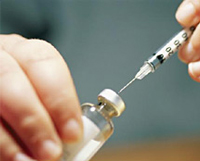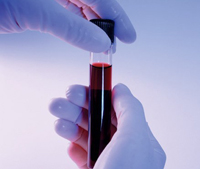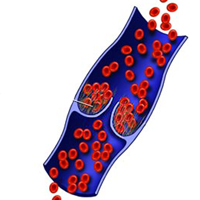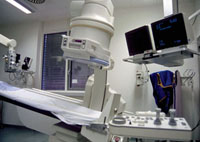Diagnosis of deep veins thrombosis is based not only on the use of simple samples, but also on the use of instrumental methods that allow with maximum accuracy to establish the character of thrombosis. The main treatment of the disease is drug therapy
Content
Diagnosis of deep veins thrombosis
Diagnosis of deep veins thrombosis begins with a patient inspection. Before conducting instrumental research methods, the doctor usually conducts a number of so-called burning samples, which are carried out using elastic binting of the legs. Next, the doctor assesses the sensation of the patient, the nature of the filling of the veins, blood current on them. Usually, the so-called marching test is used to diagnose deep veins. At the same time, the patient's foot is binting the elastic bandage, from the tips of the fingers to the groin fold, after which the patient should go for a while. If the patient has inspection pain in the field of legs, and subcutaneous veins do not fall, then this indicates a violation of deep veins, the cause of which is thrombosis.
Modern diagnosis of vascular diseases, including the lower extremities, is carried out using invasive and non-invasive research methods:
- phlebography
- Doppler ultrasound examination
- Impedance PlentyMography
- Radionuclide scanning
Phlebography (distal ascending) is the most accurate diagnostic method for detecting deep vein thrombosis. In one of the subcutaneous veins of the foot below the harness, squeezing veins in the ankle area, a contrast agent is introduced to direct the movement of contrast to the deep vein system. Next, the radiography of the under study under study is carried out. The presence of blood clots is detected on the radiograph in the form of a defect defect by contrast.
Doppler ultrasound examination and duplex scanning - methods based on ultrasound examination of vessels. These methods allow you to determine the change in the speed of blood flow, the condition of the wall and valves of the veins, as well as the thrombus.
Impedance PlentyMography - Research Method, which allows you to determine the rate of changes in the volume of blood flow of the shin.
Radionuclide scanning - is that a special radioactive drug is introduced into the vein of the feet, which accumulates in a thrombe, after which the scanning is performed demonstrating the level of the clomb position.
Treatment of the disease
 Treatment of the deep vein trombosis of the lower extremities lies in drug therapy, minimally invasive interventions, less frequently need traditional surgical intervention. It is important to remember that treatment should be carried out in the hospital, due to the possible development of hazardous complications (pulmonal artery thromboembolism).
Treatment of the deep vein trombosis of the lower extremities lies in drug therapy, minimally invasive interventions, less frequently need traditional surgical intervention. It is important to remember that treatment should be carried out in the hospital, due to the possible development of hazardous complications (pulmonal artery thromboembolism).
Strict bed regime, in a hospital with an elevated position, it is necessary to improve the outflow of venous blood out of the legs, which serves as if the prevention of further formation of thromboms.
The use of heparin - anticoagulant - prevents the formation of other thrombus by reducing blood clotting. Heparin prevents the growth of the already formed thrombus, but he cannot dissolve it. Usually heparin is prescribed during deep veins thrombosis intravenously. Heparin treatment lasts usually about 7 days
Direct anticoagulants - preparations that are prescribed after heparin, usually within 6 months. For example, warfarin. It dilutes blood, which contributes to the prevention of education of new thrombov. In the treatment with drugs lowering coagulation, it is necessary to constantly monitor the calculation rates - coagulogram. Overdose of anticoagulant therapy can lead to bleeding.
Thrombolytic therapy is effective only at the earliest stage of blood formation. At later timing, thrombolytic therapy may cause fragmentation of thrombus and lead to pulmonary thromboembolism.
Thrombectomy - Surgical intervention, aimed at removing a thrombus from the lumen of Vienna. This procedure is carried out in such a severe thrombosis as blue phlegmasia, in which only surgical treatment is effective. Delegation in treatment can lead to the development of gangrenes - tissue alignment.
With the thrombosis of the deep veins of the lower extremities, such a state can be found as floting thrombus. This is a condition when the thrombus is attached to one end to the vein wall, and the other end of it is free. With this type of thrombus, the likelihood of its separation and development of pulmonary artery thromboembolism. Therefore, when the floting thrombus is diagnosed, the installation of a Kava filter is shown - a special filter that does not transmit blood clots in the current of the lower vein, which warns thromboembolism. Thrombolytic therapy with such a thrombe without installation of the Kava filter cannot be carried out, due to the development of thromboembolism.
Prevention of deep vein thrombosis
The simplest preventive measures aimed at preventing thrombosis development include early movements after surgery, the use of elastic bandages or stockings (which squeezing surface veins accelerate the bloodstream in deep veins), the exclusion of risk factors. In the postoperative period, many doctors prescribe patients with small doses of heparin, as well as aspirin, which also reduces blood clotting.









